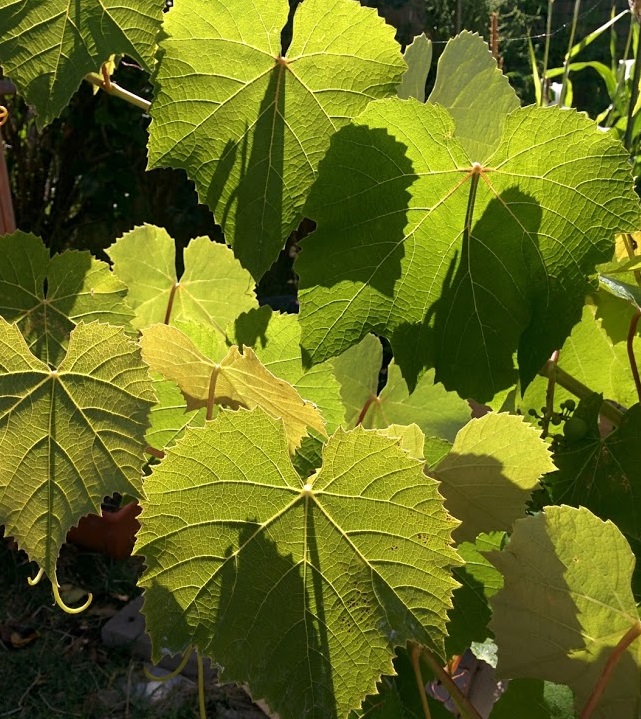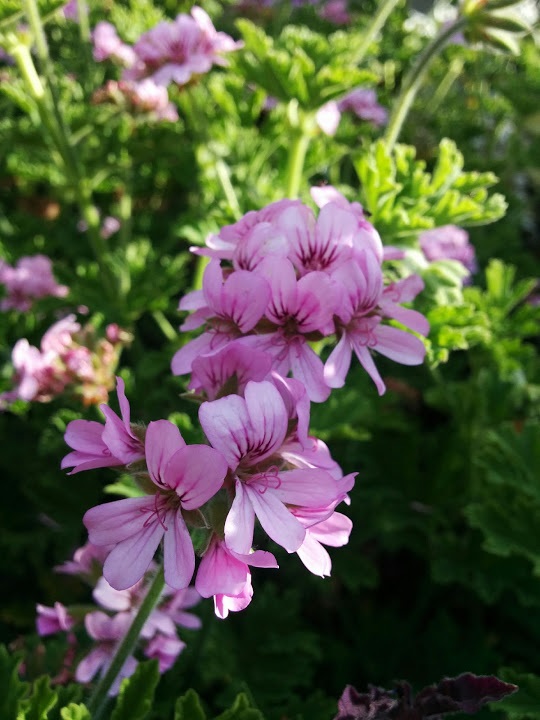I’m back with more Five at 5!
Apologies for the delay in getting the week 43 and week 44 episodes out on time, we’ve run into some technical nitty-gritty trying out new software and file transfer formats and whatnot, but it’s all sorted now and from week 45 onward, we should be back on track to have these available on time… at 5, on a Friday! 🙂
This week I’m looking with excitement at the blueberries starting to form and ripen on my blueberry bushes before I move on to another dark round “berry” – my Albany Surprise Grapevine – which is now full of trusses of sweet smelling grape flowers. Then I move on to Citronella Scented Pelargonium which I grow as a companion to my grape (more on scented pelargoniums on the November 2017 newsletter) and its little cousin, the Carpet Geranium (Geranium incanum) that I have in a hanging basket, and finally back to blue/purple in the cottage garden with the charm of Aquilegia.
Enjoy! And remember, feedback is always very much appreciated!
Click on link above to view YouTube video
1. Blueberries
 Oh for the love of summer berries! And while strawberries are already ripe and juicy in late spring, blueberries are just a while off still, with the earliest varieties ripening toward mid November, and the later ones only ready by the new year.
Oh for the love of summer berries! And while strawberries are already ripe and juicy in late spring, blueberries are just a while off still, with the earliest varieties ripening toward mid November, and the later ones only ready by the new year.
Blueberries prefer free-draining soil, and lean towards needing a higher acidity in the soil (they are part of the Ericaceae family which include other acid-loving plnats such as azaleas and heathers).
Some blueberries are self-fertile (rabbit-eye variety), while others (highbush and lowbush varieites) need cross pollination. It is always better to get two blueberry bushes even with the self-fertile ones as your fruit set will be dramatically improved if it can cross-pollinate.
They are quite easy to grow with some basic pruning needed to increase fruit, and mulching requirements to up the acidity level and retain water. Even if you are in the northern parts of New Zealand with sub-tropical climate, there are blueberry cultivars that require very little chill hours to produce enough fruit.
Somewhat drought tolerant, it is best to irrigate well while the fruit is developing, and remember to protect the juicy berries from the birds.
Besides the production of vitamin and anti-oxidant rich fruit, blueberries are a lovely ornamental garden plant with coloured leaves through the seasons (deciduous types) and the pretty white flowers in early spring.
2. Albany Surprise Grape
 A grapevine sprawling over a pergola has always been a dream of mine, and it’s finally coming true! A few years ago I found a little neglected Albany Surprise Grape in the discount section of a market and just had to get it (I lived in Albany at that point and thought it was just meant to be!). The grape was in a pot for two years, and really did not do well…until I planted after moving into my latest rental… It has grown phenomenally well the past two seasons – enough for me to make many new cuttings from it, and even have bunches of grapes at end of season. This year it is positively covered in trusses of flowers!
A grapevine sprawling over a pergola has always been a dream of mine, and it’s finally coming true! A few years ago I found a little neglected Albany Surprise Grape in the discount section of a market and just had to get it (I lived in Albany at that point and thought it was just meant to be!). The grape was in a pot for two years, and really did not do well…until I planted after moving into my latest rental… It has grown phenomenally well the past two seasons – enough for me to make many new cuttings from it, and even have bunches of grapes at end of season. This year it is positively covered in trusses of flowers!
Grapes are known as the food of the gods, for good reason! They are super nourishing, supportive of almost all of the body’s functions, vitamin rich, anti-inflammatory… and just plain delicious!
Almost all parts of the grapevine is edible – leaves are used to make dolmades (stuffed grape leaves), fruit are eaten fresh, dried, juiced and fermented (wine!), while the tendrils and flowering trusses can be cooked as vegetables, and even the seeds deliver an edible oil – grapeseed oil.
The Albany surprise grape is bred in NZ, and is an easy to grow, generally disease and weather resistant table grape cultivar with dark sweet juicy red grapes that ripen toward the end of autumn.
Grow grapes in a full sun position in free-draining soil.
3. Scented pelargonium
 Scented pelargoniums are part of the Geranium family, and are often referred to as scented geranium, although they fall in a different genus specifically (Pelargonium vs. Geranium).
Scented pelargoniums are part of the Geranium family, and are often referred to as scented geranium, although they fall in a different genus specifically (Pelargonium vs. Geranium).
From chocolate scented to spice-scented, or those reminiscent of apple, rose, peppermint or nuts… there is a large variety of scented pelargonium cultivars available and some are low and bushy while others can scramble out of control in a garden if not kept in check.
This one in particular is a citronella scented pelargonium, and like citronella grass, contain citronellol (aka dihydrogeraniol), which is marketed as an anti-mosquito agent. Using it to deter mosquitoes may work to some extent, but I believe evidence may show that mosquitoes develop a desensitization toward citronella during the course of an evening…
Scented pelargoniums are great companion plants in the garden, noted in particular for grapes, so I thought I’d give it a try – I actually have around the four corners of my grape pergola, 4 different pelargoniums growing – a citronella scented (featured), ginger scented, peppermint scented, and rosy-mint scented). So far the pelargoniums and the grape is doing superbly well, so a combination that I’d happily recommend.
For more on how to use and grow scented pelargoniums – the November 2017 newsletter is chock-full of information.
4. Carpet Geranium
 I was gifted this beautiful little thing only the beginning of this year, and have been overjoyed with it. The fine feathery grey-green leaves make a beautiful mat, and now the blooming of the perfect purple little geranium flowers!
I was gifted this beautiful little thing only the beginning of this year, and have been overjoyed with it. The fine feathery grey-green leaves make a beautiful mat, and now the blooming of the perfect purple little geranium flowers!
These make superb lower growing plants for the mixed border fringes, or they do well in containers. As long as they have full sun or partial afternoon shade, and free draining soil, they are a very giving and easy plant to grow.
According to my research this is also a traditional healing plant, used by African people, and sometimes in Europe to make a medicinal tea (leaves) that may provide relief from menstrual cramps, bladder infections and other “woman’s compliants”
5. Aquilegia
 Aquilegia have been part of cottage gardens since Victorian times, and with the many colours available and fanciful names like “Tequila Sunset” or “Lime Sorbet”, they are as popular today as they were in ages gone by.
Aquilegia have been part of cottage gardens since Victorian times, and with the many colours available and fanciful names like “Tequila Sunset” or “Lime Sorbet”, they are as popular today as they were in ages gone by.
These clump-forming herbaceous perennials have ternately divided (arranged in threes) basal leaves and tall stalks of flowers with characteristic “spurs”. They grow really easily in almost any fertile, moist and well drained soil and do equally well in sun or partial shade. They self-seed freely, allowing many volunteer plants to come up year after year.
They used to be used medicinally (under strict medical supervision) but this practice has fallen out of favour and the plants are actually noted as containing poisonous alkaloids and are definitely not for consumption. Perhaps also important to note that you may hear of aquilegia flowers being edible, however in my research this is only true specifically to Aquilegia caerulea, NOT just any old aquilegia. So enjoy them as pretty plants, and nectar-rich sources of food for insects only.
Thank you
I hope you’ve enjoyed this week’s walk through my garden. See you back next week for more Five at 5.
Notes:
1. I do not run affiliate programs, if I mention a product or a nursery in my posts, it is without monetary or any other incentive from them to do so, and because I either believe in their product, or it was the only place to get what I needed.
2. I am proud to say that my daughter has edited all the video! Go PrincessDestinyJewel10!
